DEATH OF A RIVER
Sand and gravel excavators and dumpers near Sohach Bridge in what locals say is ‘the biggest-ever gravel-lifting operation in the Kunhar riverbed’ | Photos by the author / White Star
Driving from Gilgit to Kaghan, the glittery alpine scenery on the Karakoram Highway (KKH) abruptly changes to a rather desolate — but equally breathtaking — landscape, as one crosses the Indus at Raikot Bridge. A sharp left turn and a hair-raising 45-minute jeep ride to Tattu village, followed by a 2-hour trek, put you in pole position for a night stay at the 13,000-feet-high Fairy Meadows.
The meadows offer a dazzling view of the ‘Killer Mountain’, Nanga Parbat, the world’s ninth highest peak at 26,660 feet. On KKH, 50 kilometres ahead lies Chilas — the gateway to the Kaghan Valley. And after another 30 steep and twisty miles, the dazed driver is on top of Babusar — a mountain pass at 13,700 feet in the north of the valley.
The mountain ranges of Kaghan are offshoots of the great Himalayas, entering from the east through Kashmir. The ones flanking the east bank of Kunhar River are home to the 17,200-feet-high Malika Parbat, and the 13,378-feet-high Musa ka Musalla in the west.
Far from the madding city crowds, to be surrounded by so much natural beauty is a rare treat. The treat however is short-lived. Unfortunately, it seems, humankind cannot help but interfere with nature.
‘A river doesn’t just carry water, it carries life.’ The Kunhar River, which runs all the way from the upper Kaghan Valley to below Muzaffarabad in Azad Jammu and Kashmir is not just an integral part of Pakistan but home to breathtaking landscapes, biodiversity and habitation. But unregulated construction, encroachments, extraction and pollution along it is putting this lifeline under threat
The Kunhar River basin is a humid, sub-tropical zone. Thick forests are still present across the valley but, because of extensive exploitation, thickets are mostly found in the unapproachable areas, especially on the higher slopes.
Another 15 miles from Babusar Top leads to emerald green waters, gleaming with the reflection of the snow-capped mountains fencing Lulusar Lake; the centre of the faerie Lulusar-Dudipatsar National Park. But signs of gradual environmental degradation and callous human behaviour — indicative of unsustainable tourism and a runaway native population growth rate — are starting to show.
To keep this destructive behaviour in check, the Lulusar-Dudipatsar National Park and Saiful Muluk National Parks were established in 2003. The Khyber Pakhtunkhwa Wildlife and Biodiversity (Protection, Preservation, Conservation and Management) Act 2015 extensively covers the do’s and don’ts at National Parks. The Act prohibits many actions that would impact the scenery, flora and fauna of the parks. Prohibited actions include, “logging, felling, tapping, burning or in any way damaging or destroying, taking, collecting or removing any plant or tree”, and “polluting or poisoning water flowing in and through the National Park.”
The Lulusar-Dudipatsar National Park and the Saiful Muluk National Park are true representatives of the alpine ecosystem and an excellent landscape that harbour scores of unspoilt alpine lakes, rich in their unique fauna and flora.
Taking it all in, I decide to make a pit stop at the Demanchi restaurant, perched a little high on the left side of Lulusar Lake. Demanchi offers Pakistani dishes, barbecue and trout fish on the menu, and provides an opportunity for travellers and locals to mingle.
“Is there a place to stay at night near the lake?” I ask one local.
“The Frontier Works Organisation is constructing their rest house in the middle of the lake that should be ready soon,” the local curtly responds, pointing towards the long wall being constructed across the Lake.
But isn’t there a local motel or hotel at present?
“For the last 20 years, no one was allowed to construct in the precincts of the national park,” he says. “You will have to wait for them,” the same chap retorts sarcastically.
Constructions vs the river
Intrigued, I drive to the 1,500-foot under-construction wall. Attempts to encroach upon 20 acres of land around a smaller lake on the western bank of Lulusar are on open display here. One can see boulders and rocks being pushed into the lake.When I return to Demanchi, the loquacious chap has left and my attempts to engage other wary locals about the blatant violations prove to be futile.
General prohibitions of the North-West Frontier (now Khyber Pakhtunkhwa) Rivers Protection Ordinance, 2002 provide that:Through sheer abuse of political power, wholesale corruption in the system and the turning of a blind eye by the Suki Kinari consortium, massive illegal mining activity continues unabated till date.
(a) No person shall: construct, or undertake any related physical works of any commercial building or non-commercial building, or undertake any other developmental work, within 200 feet to be measured along the slope (lay of land) beyond high water limit on either side of the rivers or their tributaries or on a space within the limits between the banks of a river; (b) place or deposit or release, directly or indirectly, any substance into the river or their tributaries, in excess of the National Environmental Quality Standards (NEQS) notified by Government from time to time...
The degradation of the Kunhar River seems to have started in Lulusar, but it does not end there. Due to heavy erosion and subsequent degradation, especially in the upper reaches of the valley, these beautiful alpine lakes and glimmering streams are under tremendous threat of erosion and extensive sedimentation.
Driving through Besal, Jalkhand, Burawai and Battakundi, I am struck by the number of local hotels, restaurants, tea shops, fresh and dry fruit vendors, and by the rate of rampant commercialisation. Liquid and solid waste can be seen flowing into the Kunhar.
But these locals are far from the biggest disruptors to nature in the area.
The absence of any meaningful building bylaws or zoning regulations seems to be the reason for the ominous and painful destruction of Kunhar River and this beautiful valley. And the laws that are in place seem not to apply to the rich and powerful.
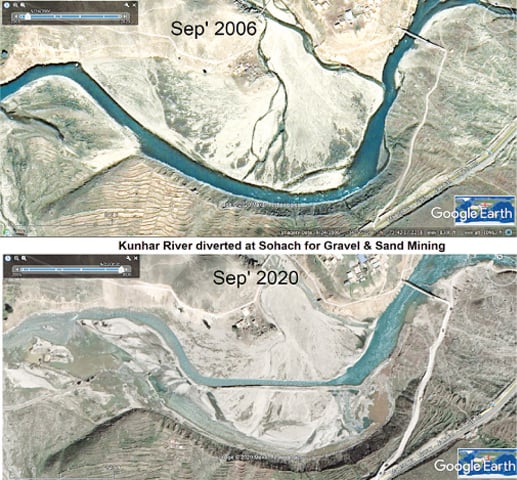
Kunhar River diverted at Sohach for gravel and sand mining (above: Sept 2006; below: Sept 2020) | Dawn GIS
The North-West Frontier Rivers Protection Ordinance, 2002 prohibits construction in the bed of the river. The ordinance also forbids lifting of the gravel in the riverbed. And yet, unfortunately, Kaghan Valley and Kunhar River are both playfields for the well-heeled.
A drive from Battakundi to Kiwai is a sombre testament to the ignorance and callousness of the locals and visitors alike. Heading towards Naran, once considered to be the jewel of the Kaghan Valley, one comes across excavators, dumpers and other earth-moving machines crawling near Sahoch Bridge, inside the riverbed.
Locals feasting in Naran’s Punjab Tikka House say that this is the biggest-ever gravel lifting operation they have witnessed in the Kunhar riverbed and that the excavations are being carried out round the clock for the last six months, in full view of public and district authorities.
According to Deputy Director Kaghan Development Authority (KDA), Mazhar Hussain, when KDA arrested the truck and excavator operators carrying out this massive operation in the riverbed, Syed Humayoun Shah, the brother-in-law of Mansehra’s PTI MPA Syed Ahmed Shah came to defend them. Eventually, the magistrate let them all off with minor fines. However, all attempts to contact Syed Ahmed Shah on the phone and Whatsapp remained unsuccessful and, despite several promises, he did not return calls.
The culprits were also able to brandish leases issued to them by the Khyber Pakhtunkhwa (KP) Mines and Minerals department. According to sources in the district authority, their attempts to stop riverbed mining also attracted the ire of none other than the Secretary, Mines and Minerals, KP.
Locals estimate that around 75 dumpers cross the Naran Bypass everyday, loaded with 8-10 cubic metres of sand and gravel from the riverbed near Sahoch, to the Suki Kinari Dam construction site. This dumper traffic has rendered Naran Bypass in complete shambles. It is estimated that, during the last six months, 125,000 cubic metres, or 200,000 tons, of gravel and sand has been lifted from the riverbed.
The Suki Kinari Hydro Power (SKHP) is an under-construction, run-of-the-river hydropower project being constructed some 20 miles downstream Naran on Kunhar River at Paludrah. The project was originally conceived in 1960 but remained dormant until March 2005, when the Private Power Infrastructure Board invited proposals for its construction. Yet, the project could not advance beyond the feasibility stage for one reason or the other.
Recently, Suki Kinari got a new lease of life. It is now being built under the China Pakistan Economic Corridor’s (CPEC’s) ‘Early Harvest’ projects. In August 2016, the KP government awarded the contract to a Sino-Pak consortium led by the Chinese state-owned Gezhouba Group and the SK Hydro group on a ‘Build, Own, Operate and Transfer’ basis. The Suki Kinari project cost is estimated at 1.8 billion US dollars and is being financed by the Industrial and Commercial Bank of China.
After completion, the dam shall be 54.5 metres high and 336 metres wide. The two-gated spillways and a three-kilometre long reservoir shall hold 9 million cubic metres of water. Its four turbines are expected to generate 870 MW of electricity. However, not only is the dam likely to disturb fish populations and silt-flow downstream, the sand and gravel lifting for its construction upstream will affect water-flow gradients during floods and create more erosion that could lead to the dam silting up at a much faster rate, impacting the long-term feasibility of this expensive project.
Encroachments in the riverbed
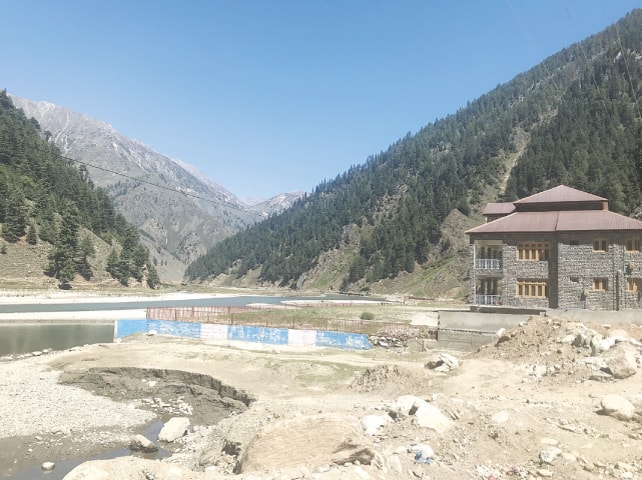
The illegally constructed NHA rest house near Naran currently lies sealed
According to sources in the Mansehra district administration, there are 257 blatant encroachments in the Kunhar riverbed and its tributaries. The district administration claims that they plan to move against these soon.
Near Sahoch a hotel is being built on an acre of land that’s either reclaimed in the riverbed or barely on the left bank of the Kunhar. Either way, it’s in violation of general prohibitions under the River Protection Ordinance 2002. It is widely alleged to be owned by a retired lieutenant general of the Pakistan army.
The next peculiar reclamation of land out of the Kunhar riverbed is between Dum Dama and Naran, where three acres of the riverbed have been encroached upon by the military-run Frontier Works Organisation (FWO), for a helipad and a maintenance base for trucks, excavators and other earth-moving machines — with muck and grease oozing into the river. Another six acres of the adjoining riverbed have also been fenced for unknown reasons.
Just a little ahead, the National Highway Authority (NHA) has built their rest house on an acre of reclaimed land inside the left bank. In an attempt to protect the rest house from the vagaries of the Kunhar, the NHA had to reclaim an additional acre of land upstream. Because of blatant violations of the River Protection Ordinance 2002, and illegal construction of the rest house in the riverbed, the KDA sealed the property and is awaiting orders for its demolition. Meanwhile, NHA bosses seem to be in a quandary, as they had already sublet the property to a private operator before the sealing orders, according to sources within the NHA.
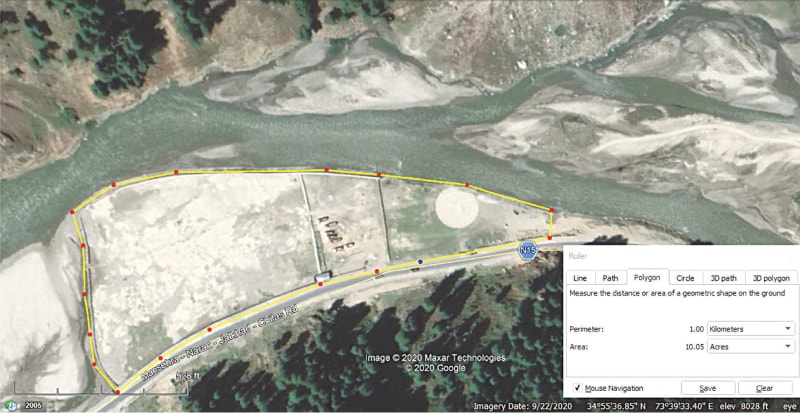
The FWO has encroached on the riverbed between Dum Dama and Naran for helipad and maintenance base for vehicles | Dawn GIS
Naran town is situated on the left bank, about a mile off Kunhar River. Dozens of hotels have also been built on two sides of the Naran-Saiful Muluk Road. The town has changed beyond recognition during the last 10 years, with hundreds of densely built hotels, shops and restaurants in the town centre dominating the scenery. More than 60 percent of the 5,000 or so hotel-rooms in Kaghan valley are cramped up in less than a quarter of a square mile, with an equal number of rooms sprouting up in Naran by the day.
Further up in the mountains, Lake Saiful Muluk, another key contributor to the Kunhar River, is located at the foot of Malika Parbat, east of Naran. The lake is rich in biodiversity, stuffed with large brown trout, many species of blue-green algae and over two dozen species of vascular and flowering plants. About a mile long, and half a mile wide, with an average depth of 150 feet, Saiful Muluk covers an area of over 12,000 acres, and is categorised as a glacier-fed lake. It is part of what is classified as a ‘permanent snow, alpine meadow’. Once known for stories of leprechauns dancing on its clear blue waters, Saiful Muluk is also racing towards an environmental disaster.
Thousands of tourists, encouraged by the increasingly dreadful sanitary conditions, callously toss their empty tetra pack cartons, plastic bags and oily newspapers that once held samosas and pakorras, in and around the lake. Occasionally, used baby diapers and other refuse can also be seen floating in the once pristine blue waters.
Many auto-workshops have also cropped up near the lake for the emergency service and repair of vintage Toyota Jeepsters, which are the primary means of transport for the tourists. Most of these open-air workshops service overheated engines, faulty hydraulics etc.The North-West Frontier Rivers Protection Ordinance, 2002 prohibits construction in the bed of the river. The ordinance also forbids lifting of the gravel in the riverbed. And yet, unfortunately, Kaghan Valley and Kunhar River are both playfields for the well-heeled.
The land around the Kunhar tributary from Saiful Muluk drops 2,500 feet along the six-mile road to Naran, and belongs mostly to the forest department. However, several massive hotels are fast cropping up between the road and the Saiful Muluk nullah. Some of these hotels are encroaching well into the bed of the stream, known for flash floods. The largest of these hotels being built is in the name of Shamail Khan, son of another retired general, and encroaching on 200 feet of the nullah bed.
According to one of the directors of the KDA, the provincial secretary of his department, who raided the subject hotel, “appeared extremely remorseful the next day for having done so.”
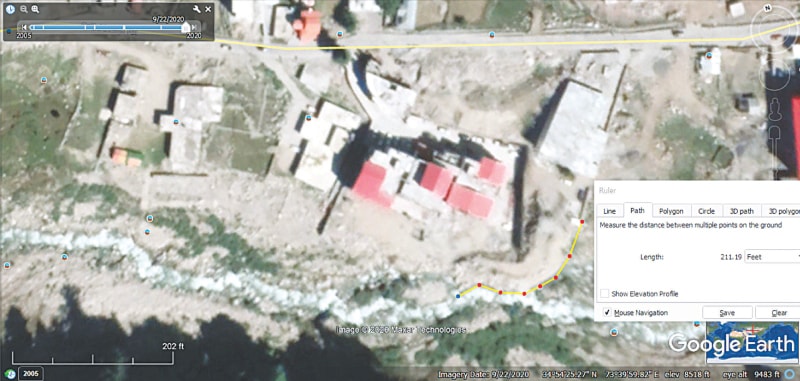
Land along the Kunhar tributary from Lake Saiful Muluk has been encroached by a hotel being constructed by the son of a retired general | Dawn GIS
However, the North-West Frontier Rivers Protection Ordinance, 2002 provides that:
(1) Where an offence of encroachment upon a river or its tributary or indiscriminate disposal of solid waste or flow of untreated water into a river or their tributary is committed by a body corporate or a firm, then every director, manager, secretary, or officer of servant of the body corporate, or every partner, manager or official actively concerned in the conduct of business of such firm, as the case may be, shall be deemed to have committed the offence, unless he proves that the offence was committed without his knowledge or that he used all his efforts to prevent the commission of such an offence.
(2) Any offence committed by any person under this Ordinance shall be deemed to have been committed at the instance of the owner, landlord, employer, lessor, licenser, mortgager, manager and any other person in charge of the premises, building or land for the time being, and the burden of proving otherwise shall lie upon such person.
On the matter of punishments, the Ordinance states:
(1) Whoever is found guilty of an offence under the provisions of this Ordinance, shall be punished, with imprisonment which may extend to six months, or with fine which may extend to five hundred thousand rupees, or with both: Provided that the punishment of imprisonment, in no case, shall be less than one month and the amount of fine, in no case, shall be less than ten thousand rupees.
(2) Whoever fails to remove an encroachment within ten days of the receipt of a legal notice shall also be punished with the same punishment as mentioned in subsection (1)
Gravel and sand mining
For thousands of years, sand and gravel have been used in the construction of roads and buildings. However, unregulated sand mining has resulted in the erosion of riverbanks, increasing flooding and causing a severe threat to biodiversity.“Channel incision is the most common physical impact of sand and gravel mining whereas habitat disturbance, alteration of riparian zones, and changes to downstream sediment transport are other serious impacts of this uncontrolled activity,” says Muhammad Moazzam Khan, Technical Adviser to WWF Pakistan. “Ecosystem attributes affected included macroinvertebrate drift, fish movements, species abundance and community structures, and food web dynamics.”
According to a post on the IUCN ‘Red List of Ecosystems’ website, despite the countless benefits that river ecosystems bring, today they are among the most threatened on the planet. The increasing use of land and associated channeling (dams and hydroelectric plants) have led to the deterioration of the functions and services of these river landscapes.
The illicit gravel and sand mining in the Kunhar riverbed is a serious cause of concern for environmental experts. Mindless excavation lowers the riverbed in different spots, which results in localised changes in gradient and sudden consequent increase in flow velocities. During flood seasons, an abrupt change in bed-gradient amplifies the rate of bed erosion, triggering massive quantities of gravel and sand to move downstream.
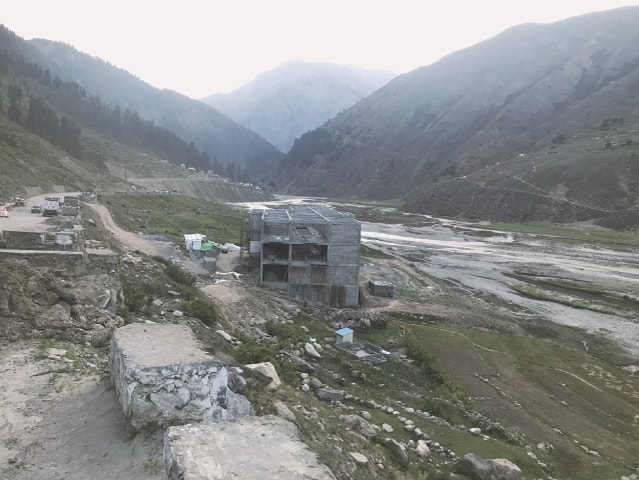
Another under-construction hotel in the riverbed near Sahoch allegedly owned by a another retired general
According to sources in the Mansehra district administration, no government agency has conducted any study to assess as to where or how much sand and gravel mining is possible in the bed of Kunhar River.
On September 22, 2020, Dawn reported, “...the chief secretary has written a letter to the Mines and Mineral secretary saying the river sand and gravel [that] is widely being exploited as aggregate for construction is often mined directly from the river channel, floodplain and adjacent river terrace deposits.”
The letter noted that the Mines and Minerals department, in most cases, had issued leases and licences for such mining. “Also, there are reportedly illegal extractions along riverbanks in the province, especially in [the] tourist areas of Malakand and Hazara divisions,” the letter had further stated.
The chief secretary’s office had added that KP Chief Minister Mahmood Khan had ordered a halt to riverbed mining in a recent cabinet meeting, claiming that the impact on the environment was much more than the revenue generated for the government from such activity.
Even earlier, the deputy commissioner Mansehra had repeatedly imposed Section 144, banning the lifting of sand and gravel in the Kunhar riverbed. But through sheer abuse of political power, wholesale corruption in the system and the turning of a blind eye by the Suki Kinari consortium, massive illegal mining activity continues unabated till date.
Killing it softly
Of late, Pakistan has been struck by more than a dozen furious storms, followed by massive flooding, substantial loss of lives and damage to infrastructure. Such events match the World Meteorological Organisation’s projections of frequent and intense weather events during the years to come.Thoughtless construction and quick solutions only exacerbate the problem.
Desirable change can be brought about if the government is vigilant. We have seen this the past. In December 2010, the Poonch River, its tributaries and their beds were designated as River Poonch Mahseer National Park. According to Sardar Javaid Ayub, secretary Wildlife, Fisheries & Tourism in Azad Jammu and Kashmir (AJK), over the past decade, ever since there have been checks on the illegal lifting of gravel and sand and illegal fishing, the population of the Mahseer fish has multiplied “several folds.”

The Kunhar River | Dawn GIS
“Due to human interventions, usually illegal mining and in-bed constructions by the powerful and the greedy, water channels erode laterally and vertically,” Ayub tells Eos. “Such activities result in flooding, and damage to the natural habitat of endangered species and existing infrastructure in and around the channel.”
Writer Amit Kalantri once wrote, “A river doesn’t just carry water, it carries life.” And so the death of a river doesn’t just impact water, but the life within it. While Kunhar River is an integral part of Pakistan, it is also a natural habitat for many species.
A study conducted by Khalid Usman et al to identify fish fauna at different sampling sites in River Kunhar was published in the Journal of Entomology and Zoology Studies in 2016. Fish samples were identified by using various keys and literature. According to the study, Cyprinidae also known as “carp” are the most commonly found fish in Kunhar River. But other species, such as Nemacheilidae or stone loaches (pathar chatta), a family of traditional bony fish, Salmonidae — ray-finned fishes which include salmon and trout — and Sisoridae — catfish that live in fast-moving waters and often have adaptations that allow them to cling to things in their habitats — are also plentiful in the river.
The study concluded that an increase in anthropogenic activities and pollution — resulting from human activity, illegal fishing and tourism — is threatening the decline of fish fauna in River Kunhar. If requisite conservation steps are not taken, it will result in the endangerment of fish in the river Kunhar.
While the Kaghan Development Authority has recently acquired some machines and equipment for solid waste management, because of topographic challenges, the safe disposal of the solid waste or sewage generated by tourists and the local population appears to be a Herculean task.
Over-pumping of underground water is also putting great pressure on the Kunhar. A rampant VIP culture and political compromises, and an extremely weak enforcement effort by the wildlife department is acutely affecting the safety of migratory and resident fowl, as well as other threatened wildlife.
It is high time we took thoughtful action and learnt to co-exist with nature. We must let the rivers flow freely, and not force them to fight back. Because humankind is no match for Nature’s wrath when it comes.
The writer is a former administrator of Karachi, currently working with the Dawn Media Group
Published in Dawn, EOS, November 29th, 2020

DEATH OF A RIVER
‘A river doesn’t just carry water, it carries life.’ The Kunhar River, which runs all the way from the upper Kaghan Valley to
www.dawn.com

